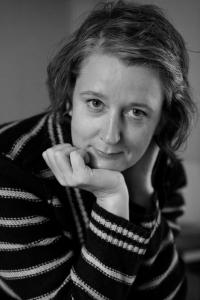 Today’s guest Claire Fuller has visited me before on the Literary Sofa and it’s lovely to have her back. When I read her debut novel Our Endless Numbered Days before publication, little did any of us know that it would go to take the 2015 Desmond Elliott Prize for a first novel – and yet it was no surprise when it did. In that story Claire created not just a richly imagined place, but an entire way of living – a very unorthodox and precarious one – in the wilds of a German forest. Her new novel Swimming Lessons draws on the more recognisable setting of the Dorset coast, a beautiful area I know having grown up in neighbouring Wiltshire. Since reading this book felt like a return visit, I invited Claire to talk about her experience of the location and how it translated onto the page. (My review follows):
Today’s guest Claire Fuller has visited me before on the Literary Sofa and it’s lovely to have her back. When I read her debut novel Our Endless Numbered Days before publication, little did any of us know that it would go to take the 2015 Desmond Elliott Prize for a first novel – and yet it was no surprise when it did. In that story Claire created not just a richly imagined place, but an entire way of living – a very unorthodox and precarious one – in the wilds of a German forest. Her new novel Swimming Lessons draws on the more recognisable setting of the Dorset coast, a beautiful area I know having grown up in neighbouring Wiltshire. Since reading this book felt like a return visit, I invited Claire to talk about her experience of the location and how it translated onto the page. (My review follows):
There are two ways to the Isle of Purbeck, a sandy, hilly, heathy place full of sky and wind. The first is via a little chain ferry that takes foot passengers, cyclists and a few cars across Poole harbor to Shell Bay and the long winding road that passes through Studland, Ulwell and onto Swanage. And the other is by driving, because although the Isle of Purbeck is almost completely surrounded by water, it isn’t an island at all but a lumpy peninsula on the south east corner of Dorset.
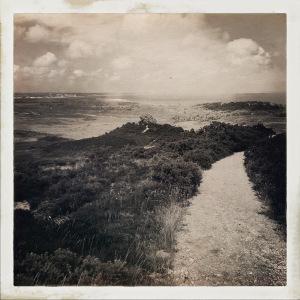
We might have come over on the ferry but I don’t remember that short stretch of water, or Ferry Road, and not much about the chalet, because back then Karen and I were more interested in pretending not to look at the boys on the beach who were not pretending to look at us, or hanging around the penny cascades waiting for another coin to drop into the trays below.
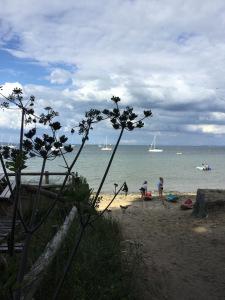
When I came to thinking about my second novel, Swimming Lessons, I decided very quickly that it would be set by the sea, and when I needed a location, it was easy to choose the village of Studland around the coast from Swanage, with the beaches and the Agglestone playing significant roles, as well as Old Harry Rocks – the sea stacks at the end of the cliffs above Studland.
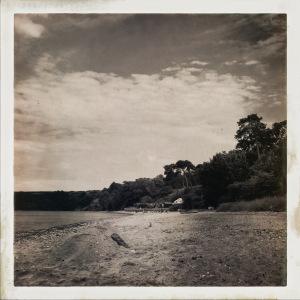
So I had the place in mind, and it really wasn’t too much of a hardship to go to the beach for research. All I needed was the house the Coleman family could live in. Of course, this didn’t have to be an actual house in Studland (I moved the London house in my first novel, Our Endless Numbered Days from Hampstead to Highgate), but I found one for sale on Rightmove, which looked perfect. It would have been fun to write that this is an article about how I bought a house for research purposes, and I did consider phoning up and pretending to be a prospective purchaser so I could see the inside, but in the end I went one better. When my husband and I were again visiting Studland and walking around the village I saw a different house tucked away opposite the pub. It looked like a converted cricket pavilion.
Back at home I Googled it and discovered it was in fact a converted tennis pavilion owned by the National Trust who let it out as a holiday home. Last summer, just as I was working on the final edits of Swimming Lessons we rented it for a week and our now-grown children and their friends came back to Studland with us.
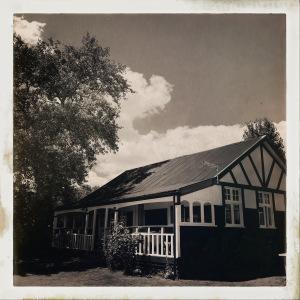
Thank you to Claire for this welcome burst of summer and sea air – I always really enjoy hearing about an author’s relationship with the place they choose to set a story.

It must be a challenge to follow an award-winning debut, particularly when the second novel has a more conventional premise, but Swimming Lessons fulfils expectations, proving that the well-trodden territory of marriage and dysfunctional family dynamics (which happens to be my home ground) can still feel fresh and distinctive in the right hands. The author also gets credit for pulling me into the story of a missing person when I thought I’d reached saturation point. There is so much to savour here: the elegant prose alive to all the senses, the insights into human nature and relationships which result in such engaging characterisation, and the sophisticated yet unobtrusive structure which produces a skillful accretion of revelations. In a way which reflects one of the book’s best lines, this is a story which leaves space for the reader’s own interpretation when all too often things are hammered home. It also offers a perceptive and honest take on parenthood and sexual politics, inviting reflection on how much – and in some respects how little – social attitudes have changed. This excellent and absorbing novel will further enhance Claire Fuller’s literary credentials and whilst I wish there were more novelists like her, I’m happy to settle for the fact she is one of a kind.


